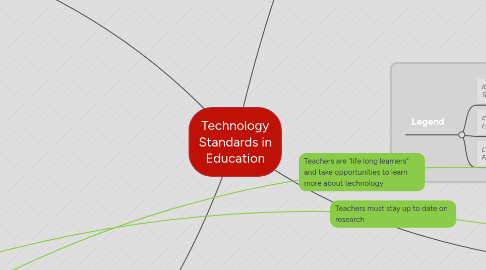
1. LTPF
1.1. Policy Direction 1: Student-Centered Learning
1.1.1. students should use technology to discover, develop and apply competencies across subject and discipline areas for learning, work and life
1.1.2. teachers should establish a vision for technology-supported, student- centered learning
1.2. Policy Direction 2: Research and Innovation
1.2.1. teachers should stay current with educational technology research
1.3. Policy Direction 3: Professional Learning
1.3.1. teachers should use technology and research to design personalized, authentic and student-centered learning opportunities to meet the diverse needs and interests of all students
1.3.2. teachers should engage in professional growth opportunities that are broadened and diversified through technology, social media and communities of practice
1.4. Policy Direction 4: Leadership
1.4.1. teachers should act as leaders in working towards more student-centered learning
1.4.2. teachers should understand how to use technology innovatively, effectively, and efficiently
1.5. Policy Direction 5: Assess, Infrastructure, and Digital Learning Environments
1.5.1. teachers and students should have access to technology
1.5.2. teachers have the economic ability and support to create a digitally-enhanced learning environment
2. ICT Program of Studies
2.1. ICT helps students understand new things
2.1.1. students should learn how to choose the right tools and techniques for various applications
2.1.2. students should learn how to apply a variety of technologies to problem solving, decision making, inquiring, and research
2.1.3. students should understand that technology has impacts in daily life and in the workplace
2.2. ICT is simply a way of doing things
2.2.1. teachers should clearly communicate that technology provides new ways in which we can communicate, inquire, make decisions and solve problems
2.2.2. teachers should teach students about *gathering and identifying information *classifying and organizing *summarizing and synthesizing *analyzing and evaluating *speculating and predicting
2.3. ICT should be integrated into other subjects
2.3.1. teacher should not focus on the technology itself, but on how technology can help students learn the required content
2.4. ICT involves an "assessment framework"
2.4.1. students must realize that technology is not simply an option anymore... they realize that they are taught it in school and must learn the skills associated with it because it is will affect many other areas of their life
2.4.2. teachers know and understand the "Classroom Assessment Tool Kit" so as to accurately assess students' technological abilities
2.5. ICT Francophone programs
2.5.1. teachers understand that technology can be taught regardless of language and may even aid in bridging the language gap
2.5.2. students who speak French as a first language should understand their right to ask for technology consistent with their language
3. EDU 210 Module 2 Assignment
4. This mind-map is meant to assist students and teachers in understanding their role in using technology as an educational tool. Others such as parents, administration, and other school staff are not mentioned so as to keep the mind-map concise and focused.
5. ISTE Standards for Students (2016)
5.1. Empowered Learner
5.1.1. students leverage technology to take an active role in choosing, achieving, and demonstrating competency in their learning goals
5.1.2. students build networks and customize their learning environments in ways that support the learning process
5.1.3. students understand the fundamental concepts of technology operations
5.2. Digital Citizen
5.2.1. students engage in positive, safe, legal and ethical behavior when using technology, including social interactions online or when using networked devices
5.2.2. students demonstrate an understanding of and respect for the rights and obligations of using and sharing intellectual property
5.3. Computational Thinker
5.3.1. students formulate problem definitions suited for technology-assisted methods such as data analysis, abstract models and algorithmic thinking in exploring and finding solutions
5.4. Creative Communicator
5.4.1. students choose the appropriate platforms and tools for meeting the desired objectives of their creation or communication
5.4.2. students create original works or responsibly re-purpose or remix digital resources into new creations
5.5. Global Collaborator
5.5.1. students use digital tools to broaden their perspectives and enrich their learning by collaborating with others and working effectively in teams locally and globally
5.5.2. students explore local and global issues and use collaborative technologies to work with others to investigate solutions
6. ISTE Standards for Teachers (2008)
6.1. facilitate and inspire student learning and creativity
6.1.1. teachers should strive to inspire students by modelling creativity, inventiveness, and innovative thinking
6.1.2. teachers should aim to make learning meaningful by incorporating real-life, authentic applications
6.2. design and develop digital age learning experiences and assessments
6.2.1. teachers should develop technology-enriched learning environments that enable all students to pursue their individual curiosities and become active participants in setting their own educational goals, managing their own learning and assessing their own progress.
6.2.2. teachers should customize and personalize learning activities to address students’ diverse learning styles, working strategies and abilities using digital tools and resources.
6.3. model digital age work and learning
6.3.1. teachers should be fluent in technology systems, tools, and techniques
6.3.2. teachers should be encouraging students to explore new technologies, instead of hindering their learning about technology
6.3.3. teachers should collaborate with colleagues, parents, students, and others to improve understanding of digital technologies
6.4. promote and model digital citizenship and responsibility
6.4.1. teachers should advocate, model, and teach safe, legal and ethical use of digital information and technology (e.g.,copyright laws)
6.4.2. teachers should model digital etiquette and responsible social interactions
6.5. engage in professional growth and leadership
6.5.1. teachers should evaluate and reflect on current research and professional practice on a regular basis to make effective use of tools
6.5.2. teachers should collaborate with local and global communities to explore creative application of technology
6.5.3. teachers should develop a vision for technology infusion in schools
